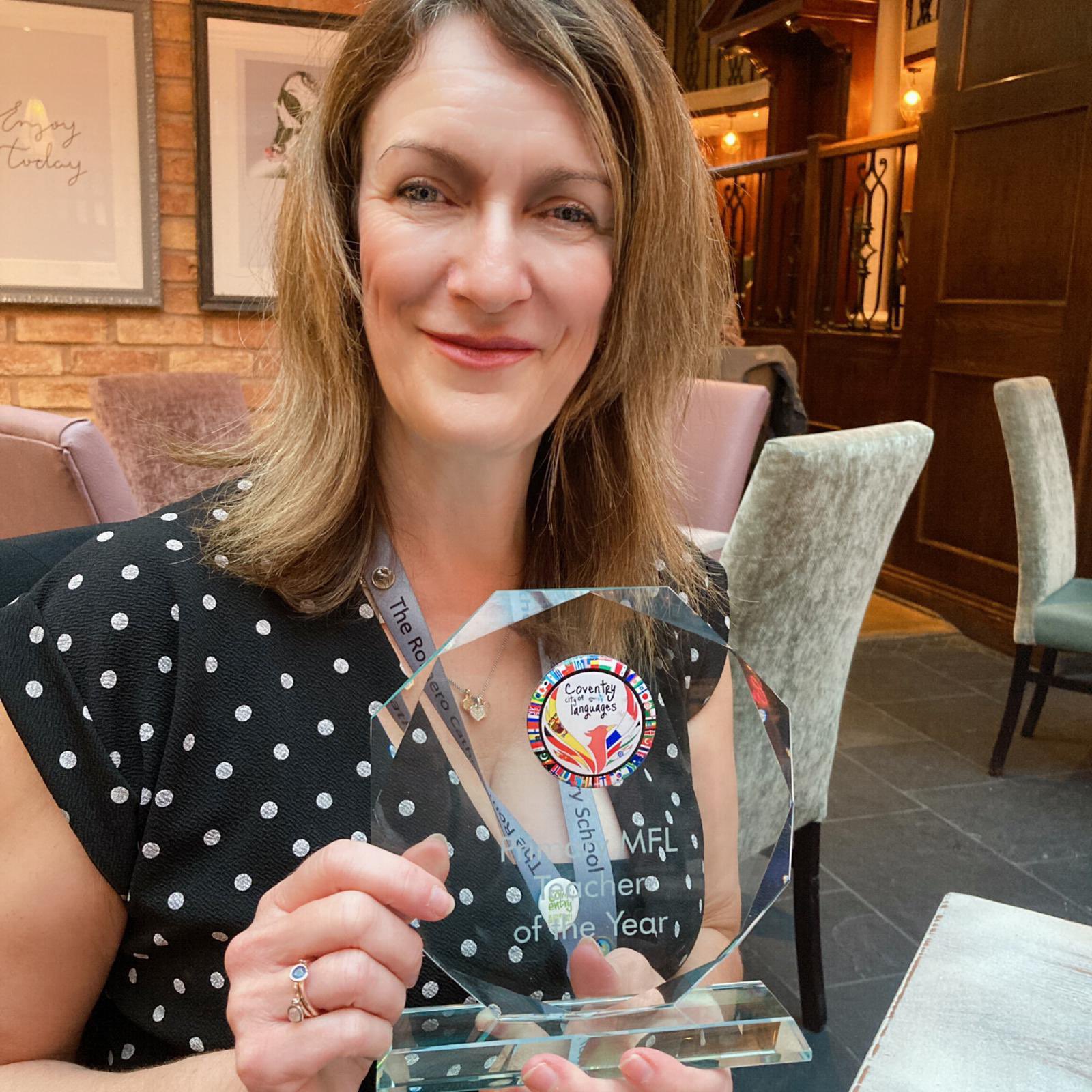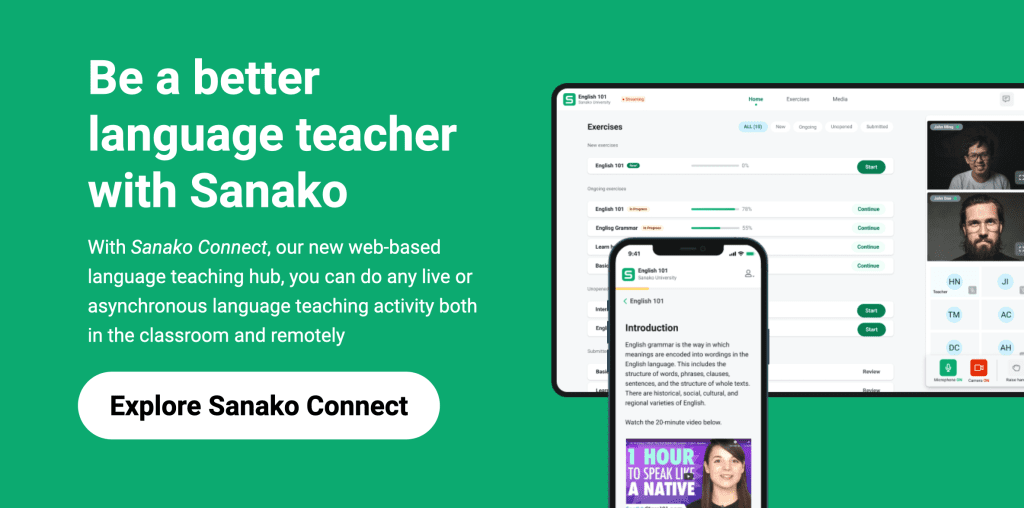In October 2021, Sanako UK sponsored two awards (Secondary Language Teacher of the year & Primary Language Teacher of the year) at the Coventry City of Languages initiative. Sue O’Malley won the Primary Languages Teacher of the year and after the event, we talked to her about her teaching career, her approach to teaching young language learners and her proudest moment as a teacher.
Primary MFL teacher of the year 2021
Sue teaches at the Sacred Heart Catholic Primary School in Coventry. It’s an outstanding school (OFSTED, 2018) with 420 pupils. It forms part of The Romero Catholic Academy, which is a multi-academy trust (MAT) consisting of seven primary schools and a large secondary school. The MAT is named after St. Oscar Romero and “exists to secure 3-19 Catholic Education in Coventry.”
Her career at the school began 7 years ago when she was hired as a Higher Level Teaching Assistant or HLTA and was charged with teaching French to Key Stage 2 students (7 to 11 years of age). The role, she says, was “rewarding and worked really well” and she was quickly given more and more responsibility. This led her to writing a curriculum plan for French and working to instil a love of language learning and a curiosity about languages in her students. Although she didn’t have a formal teaching qualification (she did hold a French degree), such was her impact that her head teacher encouraged her to get qualified and she’s now a Year 6 class teacher, working with pupils aged 10 and 11.
Like many teachers, Sue’s working life actually began outside education and she worked extensively in the logistics industry in a variety of bilingual roles. She admits that teaching “had always been something that she had thought about” post University and eventually decided to make the change after getting “a bit fed up with my job and wanting to give something back to the community.”
It’s clear that she’s never looked back and that she “absolutely loves teaching.” Sue’s particularly grateful for the support of her headteacher, who is a “huge advocate of language learning” and who encourages her to follow her instincts and be creative in her approach. But she’s quick to recognise that there are challenges – the primary curriculum is, she says, “chock-a-block” and there’s no “ring-fenced time for language learning”. This often means that language learning is “one of the first things to be sidelined in favour of more pressing topics.”
Nonetheless, Sue notes that her children are incredibly curious and “love learning languages.” In particular the EAL (English as an additional language) pupils, who tend to thrive without the focus on English as “everyone is starting in the same place.”
Since moving from being a HLTA to a fully-qualified teacher, French is now only part of the full curriculum she is expected to teach. She acknowledges that the role is “very different” and that her class now only gets “an hour of dedicated language teaching every fortnight.” For her colleagues, the amount of language teaching they deliver is impacted by “staff confidence around teaching languages.” As non-specialists, many feel “like they can’t teach it adequately or correctly”, although Sue reiterates that she’s “always available to help” and that she “created a bank of resources for everyone to use” when she joined the school.
How Covid-19 Pandemic changed language teaching?
O’Malley is keen to extend this language teaching support to all primary schools across her MAT. She is “the only specialist language teacher and the only teacher with a French or a languages degree” across the trust. She’s keen to share her expertise more broadly and would love to build on the close collaborative working that characterised the MAT’s response to the Covid-19 pandemic. But again her efforts are hindered as “languages fly so low on the list of priorities.”
Given the limited focus on language learning, it’s no surprise that lessons with Ms O’Malley usually begin by recapping previous learning. This is usually done through a game or Kahoot! quiz “just to keep that previous learning alive.” Key learning content is then usually delivered “via flashcards or a bit of role play with a partner.” Those students who are then happy to feed back to the whole class “come out to the front and have an additional role play with me or another student.” Songs always go down well and Sue loves how her students “aren’t embarrassed to get involved and they’re not afraid to have a go.”
There’s always an independent learning task for students to work through and O’Malley reserves particular praise for the resources produced by Language Angels. These resources are usually accessed in class via the interactive whiteboard, but there is also a platform for children to use, so that they can login at home and “reinforce what we’ve been learning in class.”
The theme of home learning crops up again as we start discussing how Sue’s teaching changed in response to the Covid-19 pandemic. As she says, “it was a completely new thing for us” and her school ”didn’t initially have the tools or the technology to teach remotely.” Even so it’s astonishing to hear that she began by delivering packs of printed resources to students at home for them to work through. As time progressed, Sue reverted to going into school to teach her class via Zoom – she admits that she felt “more comfortable there than teaching from home. Plus, I had all the equipment that I needed on hand.”
Ms O’Malley is clear that teaching via Zoom did not allow to replicate much of the pair / group work her class were familiar with. But she concedes that time spent teaching online has forced her to pay greater attention to the pace of her lessons and to ensure that all students are keeping up and involved throughout. This is important, she says, as “there are gaps in their learning” and that this year’s cohort “aren’t at the same level as previous years.”
But nothing sways her from her infectious love of language teaching. She clearly relishes “the enthusiasm and the curiosity of young language learners” and how proud they are to share their learning with her in the playground. She talks fondly about taking 35 children to France on the first ever European trip undertaken by her school to coincide with the 75th anniversary of the D-Day landing. She’s hoping that health conditions will improve so that they can go in 2023. “It was phenomenal” she says, “my greatest achievement in teaching, apart from winning this award, of course!”
Sanako is proud to support great teachers like Ms. O’Malley and great schools like Sacred Heart Catholic Primary School – that’s why we’re on a mission to help language teachers across the world to teach languages better and more efficiently.
Are you a language teacher interested in implementing new language learning technology tools into your language classroom? Then click here or the banner below and learn more on how Sanako supports over 50.000 classrooms globally with our teacher-led language instruction tools.


